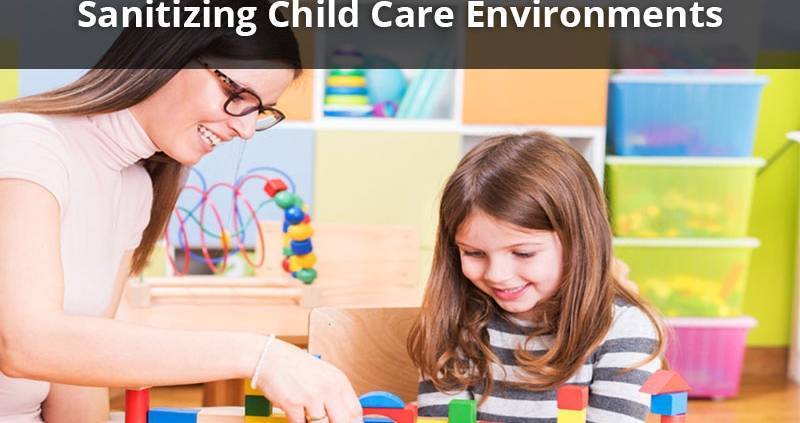Parents and childcare providers want what’s best for children. Obviously, this should include providing a clean and safe environment. Balancing cleanliness with safety can be more of a challenge than some care providers might think, though.
While harsh standardized cleaning supplies typically do a great job of removing pathogens, they can also expose young children and their caregivers to potentially dangerous chemicals. Thankfully, there are better solutions available on today’s markets. Instead of using harsh chemical cleaners, childcare providers can switch to low toxicity sanitizers for all of their cleaning needs.
Fewer Health and Safety Risks
There are a variety of benefits associated with switching to low toxicity cleaning solutions, the most obvious of which being that they are safer for children and childcare workers alike. Those doing the cleaning can benefit from reduced risk of negative health effects such as chemical burns and damage to the skin and eyes. There is also a substantially lower chance of negative long-term health impacts due to inhalation of cleaning solutions both during and after application.
Children can also benefit from the use of low toxicity cleaners and sanitizers. Exposure to traditional cleaning solutions has been shown to raise children’s risk of developing asthma, skin conditions, and other potentially serious health issues. Given that traditional chemical cleaners often leave behind harmful residues, switching to a more child-safe alternative can help to protect youngsters’ health both during and after cleaning.
Better for the Environment
Making the switch to organic, biodegradable low toxicity cleaners is better for the environment. This is true of both the immediate surroundings in which they are used and the far-reaching environmental consequences of their use.
Low toxicity cleaners ensure better air quality within daycares, schools, and other childcare facilities. They do not produce strong, chemical odors, nor do they leave dangerous fumes lingering in the air. Some of them do include subtle scents that will leave behind a pleasant smell instead of overwhelming children, parents, and care providers as soon as they walk in the door.
The environmental benefits of low toxicity cleaners also extend beyond the immediate environment in which they are being used. Switching to this more environmentally sound alternative to conventional cleaning solutions can help to reduce water and air pollution. It also produces fewer greenhouse gasses, which translates to less ozone depletion.
Improved Adherence to Sanitation Protocols
Most childcare providers aren’t too keen on using harsh chemical sanitizers. This can leave them with a difficult choice to make: follow protocols and expose themselves and the children in their care to dangerous toxins, or fail to adequately clean and sanitize the area, exposing the children to harmful bacteria, instead.
No matter what individual employees think about sanitation protocols, though, they’re put into place for a reason. No parent wants his or her child to be exposed unnecessarily to contagious diseases. It just isn’t safe.
Switching to low toxicity cleaners can help to improve adherence to sanitation protocols. Since it is not just less dangerous to employees’ health but also less unpleasant to apply these greener cleaners, most childcare workers are more likely to use them as intended. This, in turn, means that the children in their care will be less likely to be exposed to dangerous germs.
Choosing the Right Products
Not all low toxicity cleaning and sanitizing solutions are created equal, so it’s important for childcare providers to do some research prior to choosing products. They should look for a cleaning solution that is chlorine and ammonia-free that leaves behind no harmful residues. Solutions like SaniDate RTU are able to eradicate 99.9% of bacteria, including E. coli, Salmonella, Staph, and others without exposing children or their care providers to toxic chemicals. And the newly released SaniDate APD (All Purpose Disinfectant) concentrate, has an EPA label amendment approved for eradication of Coronavirus.
Only buy cleaning solutions that are registered with the EPA. This will help to ensure that their ingredients have been carefully evaluated and deemed safe. It’s important to look for EPA certification given that just about any cleaning company can start putting words like “green” and “eco-friendly” on their products, regardless of how safe they actually are for human contact.
Using Low Toxicity Cleaners
Unlike many more specialized traditional cleaners, low toxicity cleaners can be used on a wide variety of surfaces. That’s important for childcare workers. After all, small children don’t typically choose what to pick up and what to leave alone as carefully as their adult counterparts.
Low toxicity cleaners can be used to sanitize everything from tables and chairs to telephones and children’s toys. Since they don’t contain dangerous, toxic ingredients, they can even be used to sanitize kitchen countertops and other food prep areas.
The Take-Away
Keeping childcare facilities clean and sanitary is an absolute must, but it doesn’t have to involve the use of harsh and potentially dangerous cleaning solutions. Instead, facility managers should consider switching to a safer alternative such as SaniDate RTU. The workers, the children, their parents, and the environment will all be better off if they do.




Leave a Reply
Want to join the discussion?Feel free to contribute!